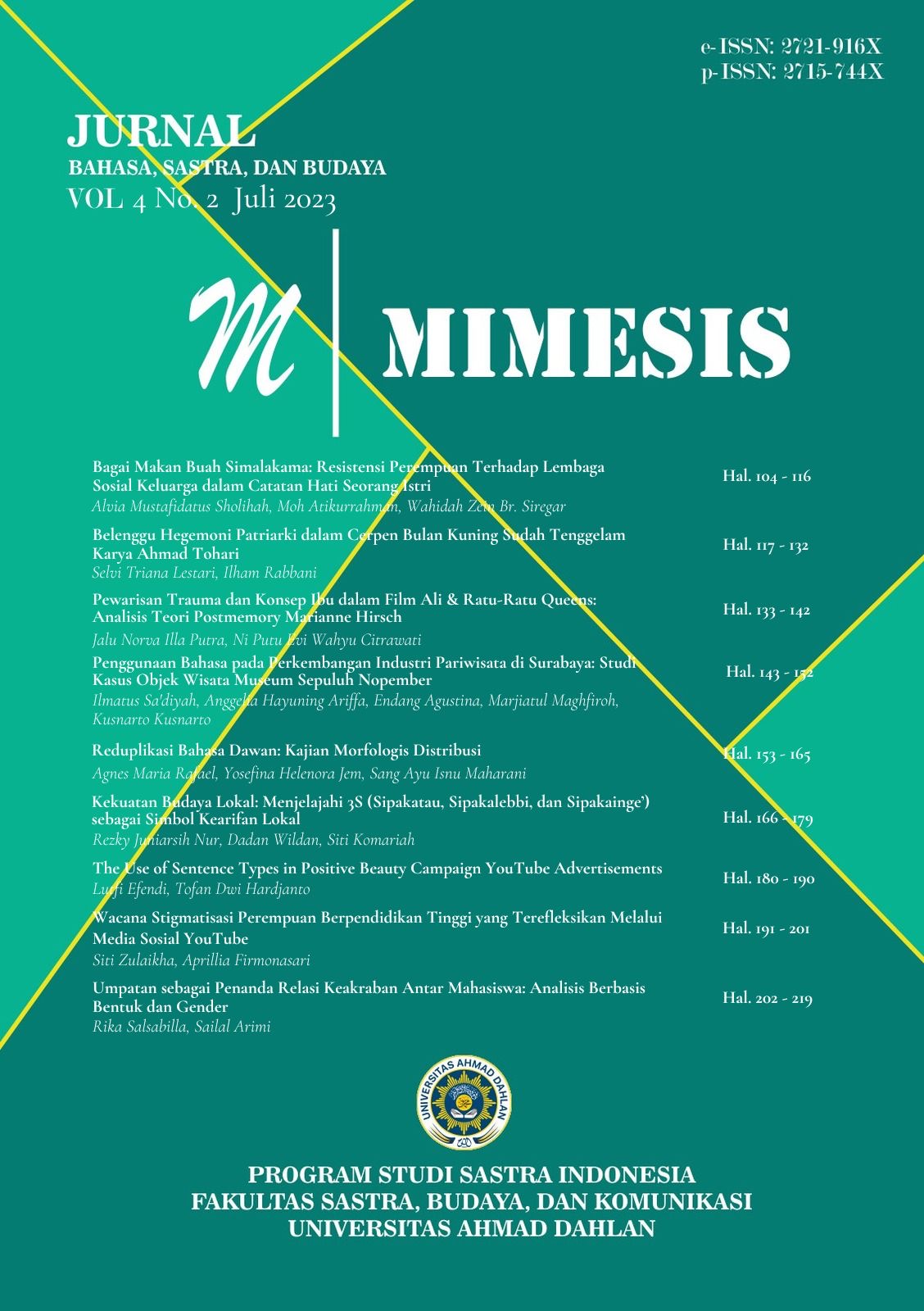Wacana Stigmatisasi Perempuan Berpendidikan Tinggi yang Terefleksikan Melalui Media Sosial YouTube
DOI:
https://doi.org/10.12928/mms.v4i2.8623Keywords:
Critical Discourse Analysis, Educated Women, Fairclough, Women's Discrimination, Women's StigmaAbstract
Verbal stigmatization is part of the linguistic phenomenon. The effects of stigmatization can be felt in the near term and the future. However, stigmatization can negatively impact victims, so this phenomenon must be ended immediately. This study attempts to dissect the stigmatizing speech of highly educated women using Fairclough's AWK framework. The results of this study at the textual level found three types of speech: regulating, degrading, and cornering. The lingual form of stigmatization is found in the speech form ah, free, what, if, just, only, and only. In addition, it was also found that lingual expressions reflect stigmatization, namely in free speech “percuma dong” and “sayang banget”. The function of using the lingual form, based on the context of stigmatizing speech above, is to bring down mentally, influence negative thoughts, limit progress, and prohibit certain things. Furthermore, at the level of discursive practice from the five data above, there is an intertextuality between the discourse from the views of patriarchal and non-patriarchal societies. It shows that the stigmatization of highly educated women reflects patriarchal cultural thinking.References
Ardianti, A. (2017). Stigma Pada Masyarakat “Kampung Gila” di Desa Paringan Kecamatan Jenangan Kabupaten Ponorogo Disusun Oleh : Stigma Pada Masyarakat “Kampung Gila” di Desa Paringan Kecamatan Jenangan Kabupaten Ponorogo Anis Ardianti. Jurnal S1 Sosiologi FISIP Universitas Airlangga, 1–27.
Dadi, D. (2021). Women Empowerment in Indonesia: Community Learning Activity Center Programs. AL-ISHLAH: Jurnal Pendidikan, 13(3), 1823–1834. https://doi.org/10.35445/alishlah.v13i3.1152
Dai, N. F. (2020). Stigma Masyarakat Terhadap Pandemi Covid-19. PROSIDING SEMINAR NASIONAL PROBLEMATIKA SOSIAL PANDEMI COVID-19 “Membangun Optimisme Di Tengah Pandemi Covid-19,” 66–73.
Eriyanto. (2015). Analisis Wacana Pengantar Analisis Teks Media (9th ed.). PT LKiS Printing Cemerlang.
Fairclough, N. (1989). Language and Power. Longman.
Fairclough, N. (2006). Discourse and Social Change (10th ed.). Polity Press.
Ginting, E., & Wiradharma, G. (2023). Live in Stigma: “Fat Shaming” of Woman (Discourse Analysis on Facebook Social Media Fat Women Association of Indonesia). 6(1), 138–145.
Gunawan, D. (2022). Perang dan Liyan: Kajian Feminisme Eksistensialis dalam Novel Lampuki Karya Arafat Nur. Mimesis, 3(2), 86–100.
KBBI Daring. (n.d.). Badan Pengembangan Dan Pembinaan Bahasa. https://kbbi.kemdikbud.go.id/entri/stigmatisasi
Kridalaksana, H. (2005). Kelas Kata dalam Bahasa Indonesia (Kedua). PT Gramedia Pustaka Utama.
Kridalaksana, H. (2009). Kamus Linguistik (Keempat). PT Gramedia Pustaka Utama.
Kridalaksana, H. (2010). Pembentukan Kata dalam Bahasa Indonesia. PT Gramedia Pustaka Utama.
Ma’shumah, N. K. (2021). Konstruksi Ideologi Pemerintah Atas Praktik Radikalisme, Anarkisme Dan Intoleran Oleh Ormas: Sebuah Pendekatan Tekstual Dan Kritis. Mimesis, 2(1), 1. https://doi.org/10.12928/mms.v2i1.3455
Moeliono, A. M., Lapoliwa, H., Alwi, H., Sasangka, S. S. T. W., & Sugiyono. (2017). Tata Bahasa Baku Bahasa Indonesia. In Tata Bahasa Baku Bahasa Indonesia edisi keempat. Badan Pengembangan dan Pembinaan Bahasa.
Prabawati, D. A. (2022). Frame dan Idealized Cognitive Model Konsep Dabeg dalam Tuturan Bahasa Jawa (Kajian Sintaksis Kognitif). Universitas Gadjah Mada.
Setiyoko, A. (2021). Stigmatisasi Kelompok Anarko-Sindikalis oleh Kepolisian Negara Republik Indonesia: Analisis Wacana Kritis. Universitas Gadjah Mada.
Sulistiyawati, R. I., & Firmonasari, A. (2022). Realita Sosial di Sekitar Wacana Kasus Kekerasan Seksual Akun @Tt_Guillaume. SASDAYA: Gadjah Mada Journal of Humanities, 6(2), 100–116. https://doi.org/10.22146/sasdaya.v6(2).100-116
Sutami, H. (2004). Ungkapan Fatis dalam Perbagai Bahasa. Pusat Leksikologi dan Leksikgrafi, Fakulltas Ilmu Pengetahuan Budaya, Universitas Indonesia.
Downloads
Published
Issue
Section
License
Copyright (c) 2023 Siti Zulaikha, Aprillia Firmonasari

This work is licensed under a Creative Commons Attribution-ShareAlike 4.0 International License.
License and Copyright Agreement
In submitting the manuscript to the journal, the authors certify that:
- They are authorized by their co-authors to enter into these arrangements.
- The work described has not been formally published before, except in the form of an abstract or as part of a published lecture, review, thesis, or overlay journal.
- That it is not under consideration for publication elsewhere,
- That its publication has been approved by all the author(s) and by the responsible authorities tacitly or explicitly of the institutes where the work has been carried out.
- They secure the right to reproduce any material that has already been published or copyrighted elsewhere.
- They agree to the following license and copyright agreement.
Copyright
Authors who publish with Mimesis agree to the following terms:
- Authors retain copyright and grant the journal right of first publication with the work simultaneously licensed under a Creative Commons Attribution License (CC BY-SA 4.0) that allows others to share the work with an acknowledgment of the work's authorship and initial publication in this journal.
- Authors are able to enter into separate, additional contractual arrangements for the non-exclusive distribution of the journal's published version of the work (e.g., post it to an institutional repository or publish it in a book), with an acknowledgment of its initial publication in this journal.
- Authors are permitted and encouraged to post their work online (e.g., in institutional repositories or on their website) prior to and during the submission process, as it can lead to productive exchanges, as well as earlier and greater citation of published work.











